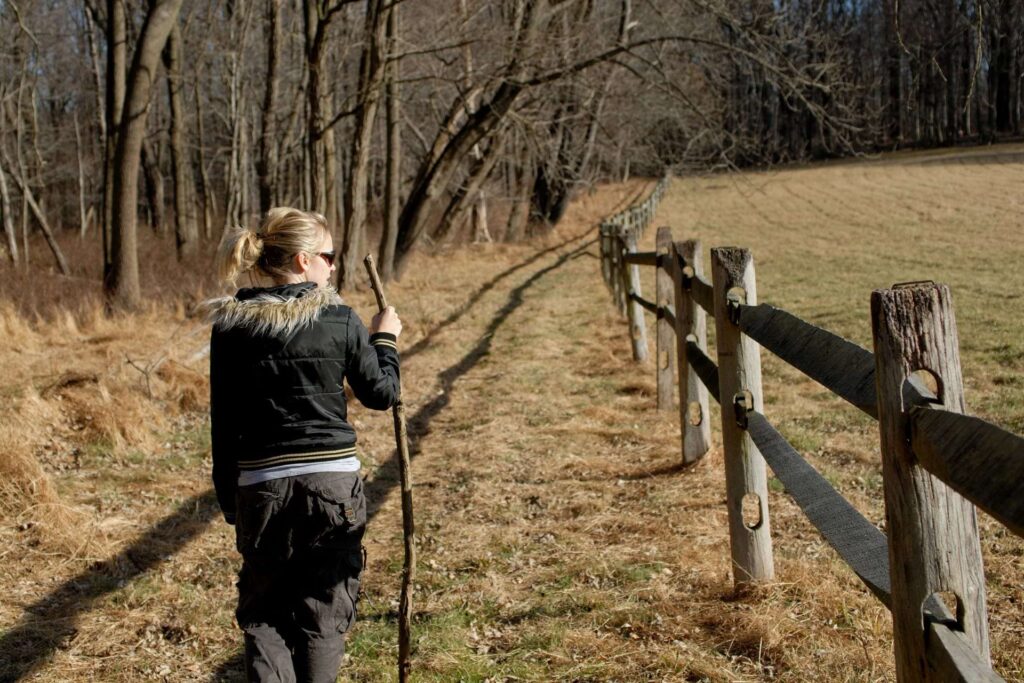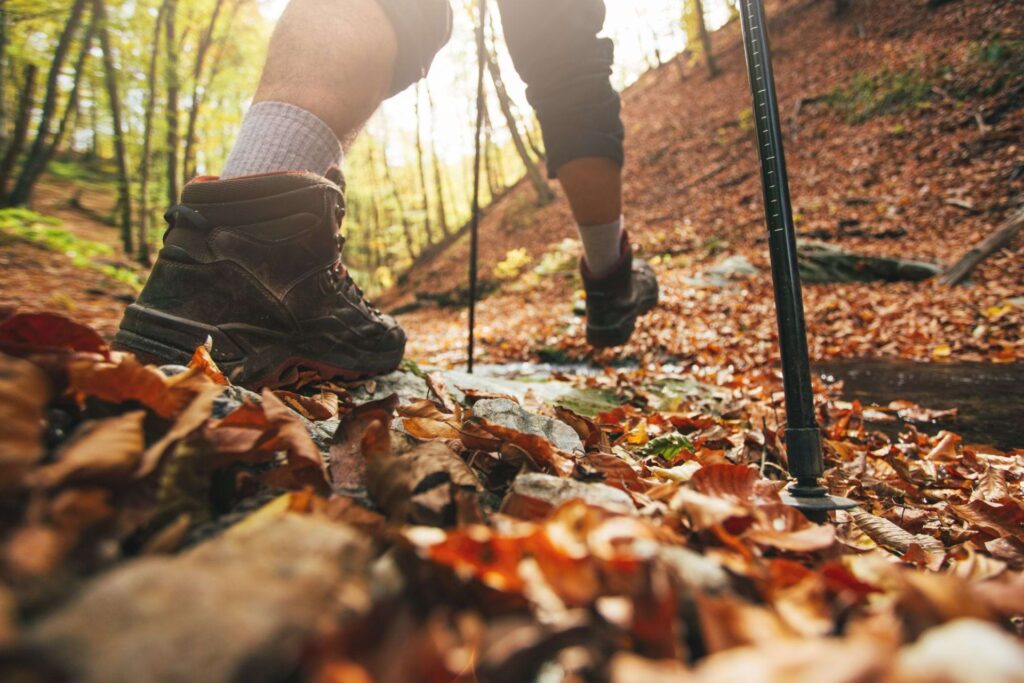Fall is a fantastic time to go hiking. The trails are quiet and less crowded than in summer, the temperature is more bearable, and the scenery is beautiful.
But if you’re used to hiking during the warmer months, you might not have the right gear to hike in the fall.
In this post, we’ll show you exactly what to wear hiking in fall and the essential gear to pack.
Looking for romantic hike ideas? We’ve scoured the US and found the most romantic hiking trails for you and your partner to explore.
Why Hike in the Fall?
If summertime is the most popular time to hit the trails, why do so many people love hiking in fall?
Stunning Views
From the vibrant foliage to the crystal waters and clear skies, the views you get when hiking in the fall are breathtaking. Whether you’re hiking up a mountain or visiting Big Pine Lakes National Park, there is something otherworldly about fall landscapes.
Easier Backpacking Temperatures
Depending on where you are, the temperatures in the summertime can be hard to bear, especially when you’re hiking for hours through dense forests. Temperatures drop during the fall, which makes for easier hiking conditions and far less sweating.
Better for Pets
If you love taking your pets hiking with you, it’s much safer to do it in the fall. Pets are at a much higher risk of sunstroke, dehydration, and overheating when they spend time out in the summer, but autumn brings much lower temperatures for them to enjoy.
Spot Migratory Birds
For bird lovers, fall is a great time to head out with your binoculars. The fall migration lasts longer than the springtime counterpart, and the flocks tend to be larger. In some parts of the US, you’ll see an exceptional variety of birds in jaw-dropping flocks heading to warmer climates.
How to Stay Safe When Hiking in The Fall

Although beautiful, fall does come with its own risks for hikers, so it’s important to be prepared.
Keep Hydrated
Dehydration is still a huge risk, even in cooler temperatures. In fact, you’re at a higher risk than in the summer because you don’t feel as thirsty, so you naturally drink less water.
You won’t feel like you’re sweating as much, but your body will be working hard under heavier hiking clothes, so it’s essential to keep your fluid levels topped up on your hike.
Stick to Trails
It’s tempting to stray away from the trails in fall and follow the fallen leaves and beautiful foliage, but trails exist for a reason. If you go trampling through the brush, you risk disturbing wildlife, not to mention it’s very easy to get lost with falling leaves constantly changing the patterns on the ground.
If you have to go off trail for any reason, make sure it’s always in sight so you can easily find your way back.
Stay Alert
Although you’ll see fewer mammals and other animals in the cold weather, that doesn’t mean they’re still not a significant threat. Keep your eyes on the trail ahead to spot any danger, and be aware of the noises around you. If you hear any crunching or rustling nearby, it could be a predator looking for a meal.
Come Prepared
A long hike or multi-day trip in the fall requires planning. If you’re used to summer hikes, you’ll need to switch out your sleeping bag for an all-season one, up your water consumption, and plan for harsh weather conditions.
The more planning you do in advance, the more enjoyable your hike will be.
Best Fabrics for Fall Hiking Clothes
We’ll talk about the best hiking clothes for fall later. But first, let’s look at the best fabrics for fall hiking clothes so you know what to look for.
- Wiking: any layer that touches your skin should have moisture-wicking properties, meaning it pulls sweat off the skin and moves it to the outer surface of the fabric, where it can dry more easily.
- Insulating: although fall can be quite mild, your mid and outer layers should still have insulating properties to trap your body heat and keep you warm.
- Waterproof: all of your outer layers should be waterproof to stop your hiking clothing from getting drenched in the rain. A jacket that is waterproof and windproof won’t keep you totally dry, but it will make a lot of difference if you encounter a storm.
- Breathable: all of your layers should be breathable to allow them to dry out more quickly. If you have any layers that aren’t breathable, you’ll sweat more and become soaked, even in cooler weather.
- UV protection: some outer layers come with a UV factor rating, which can protect your skin from the damaging effects of UV rays.
Fall Hiking Base Layers

When you’re thinking about what to wear hiking in fall, it’s best to think in layers. The base layer is the clothing that touches your skin. When planning your base layer, it’s important to think about warmth, sweat, and chafing.
- Underwear: always go with what you find most comfortable. For long hikes, you need support, a breathable fabric, and something that won’t chafe. Seamless designs and non-cotton fabrics are usually the best options.
- Bras: a sports bra that offers good support is the best option. These are usually designed to wick moisture and prevent chafing.
- Long underwear: if you know it’s going to be particularly cold on your hike, wicking long underwear can be a great all-in-one base layer. These come in lightweight options, which are perfect for fall.
- Shirts: grab yourself a moisture-wicking long-sleeve t-shirt for a fall hike. Active ranges are a great option since they’re designed to wick sweat and dry quickly.
- Pants: hiking pants or hiking leggings will be your best friend on fall hikes. They’re comfy, don’t chafe, and prevent moisture build-up.
Fall Hiking Midweight Layers
Your mid-layer provides your primary warmth. It’s always best to have a couple of options with you, which you can choose between depending on the weather.
- Fleece jacket: if it’s going to be cold, go for a fleece jacket. These come in lightweight, midweight, and heavyweight options, so choose what’s best based on the weather conditions.
- Fleece pants: you’ll only need this mid-layer if it’s going to be extremely cold. Usually, fall temperatures aren’t that severe, but it will depend on where you go hiking. If you’re going with long underwear, you won’t need these as well.
- Insulated jacket or vest: if the weather is mild enough, you’ll be warm enough with just a fleece jacket. However, you could add a puffy vest or insulated jacket as a mid-layer if you’re worried about being cold. These are lightweight and easy to carry if you get too warm.
Fall Hiking Outer Layers
Your outer layers will keep you dry if it starts raining and help insulate your body heat in the wind. Your main focus for this extra layer of your hiking outfit is rainwear that’s waterproof and breathable.
- Rain jacket: you can get soft-shell, hard-shell, or hybrid-shell waterproof rain jackets, all of which will work well as an outer layer. If you’re on a budget, a simple waterproof poncho can also work well as a quick solution for storms.
- Rain pants: waterproof pants are lightweight and easy to fold up into your backpack. Hopefully, you won’t need them, but you’ll be glad you have them if the heavens open.
Fall Hiking Footwear

The most important decision you’ll make about your fall hiking gear is what shoes you wear on the hiking trail. Nothing will ruin your hike quicker than blisters and aching feet.
- Waterproof hiking boots: A sturdy and comfortable hiking boot is great for long hikes and rough terrain. They offer good ankle support and enough grip for challenging surfaces. Hiking boots should always be waterproof or at least water-resistant, and you’ll need to break them in before your trip.
- Trail-running shoes: these are more lightweight and breathable than hiking boots, but they’re not as waterproof. If you’re going on a gentler hike this fall, trail-running shoes are a great option.
- Wool socks: choose hiking socks that are taller than your footwear to avoid chafing and on the thicker side to keep your feet warm in the fall weather. A moisture-wicking wool hiking sock is the best option to avoid nasty blisters.
Fall Hiking Accessories
Finally, we can’t forget about your hiking accessories. There are a few extra pieces of gear you’ll need to go hiking in fall.
- Hats: if it’s going to be sunny when you go hiking, go for a wide-brimmed hat or cap to protect your eyes from glare and your skin from UV rays. If it’s going to be cold, a wool or synthetic hat will help insulate your head.
- Gloves: moisture-wicking gloves are great for keeping your hands warm without causing them to sweat on mild fall hikes.
- Sunglasses: it doesn’t have to be very sunny to make you start squinting on a hike, and the more you squint, the quicker you’ll get a headache. Polarized lenses are great for reducing glare, but be wary of blind spots if you’re hiking on challenging terrain.
- Leg gaiters: these fit over your boots and pants to help prevent hiking trail dirt, rain, and even pests from getting in your boots. In the fall, there will be more debris on the trails, so these can stop the annoyance of dirt in your shoes.
Ready to Go Fall Hiking?
There’s no need to wait until the summer to explore your favorite trails. Fall is a beautiful time to go hiking, and the trails will be much less crowded, which is a great bonus.
With the right gear and route prep, you’ll be glad you ventured out in the cooler weather. Just remember – it’s all about choosing the right layers when you’re planning what to wear hiking in fall.
If you’re planning on hiking in the snow, you’ll need to know the difference between microspikes and crampons – head to our next hiking gear guide to find out which you’ll need.

